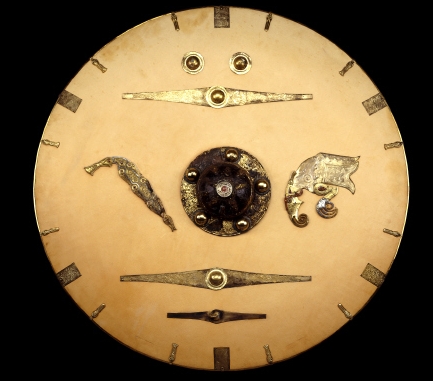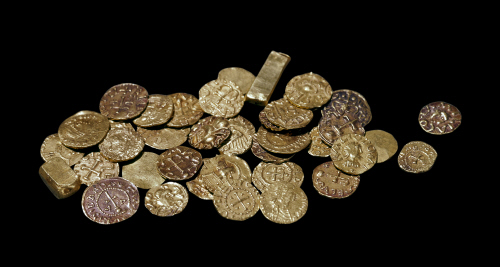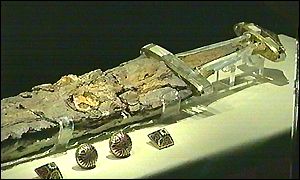

| A shield, together with a sword, makes up an important part of the set of weapons belonging to an élite warrior in the early Anglo-Saxon period. Often nothing remains except the iron boss and hand-grip as the wood of the shield board quickly decays in the ground. Here the form of the original shield has been reconstructed, with oak-bark tanned cow-hide over lime boards.
What survives are gilded emblems, including a bird-of-prey with predatory beak and cruel talons, and a six-winged dragon with open snapping jaws. These may symbolize the strength and courage of the shield's bearer. At the centre is a heavy iron boss, decorated with pairs of intertwined horses. Around the rim are gilt-bronze panels covered with interlacing animals and flanked by dragon's heads with beady garnet eyes. It is closely linked to shields from the contemporary Swedish high status cemetery of Vendel and together with the helmet, it suggests that both regions share cultural links in the late sixth and early seventh century.
| 
Reconstructed Shield from Mound 1. Anglo-Saxon, early 7th century AD © British Museum | ||||

Gold coins and ingots from the ship-burial, Suffolk, England. 1st century AD © British Museum | The burial can only be dated on the basis of the coins that were found there.
There was a purse among the burial goods, which contained 37 gold coins, 3 coin-shaped blanks, and 2 small gold ingots. The presence of the coin-shaped blanks suggests that the number of coins was deliberately rounded up to 40. It is possible that the 40 coins were to pay the men who would row the ship into the 'Otherworld', while the ingots were to pay the steersmen. The coins all come from the kingdom of the Merovingian Franks on the Continent, rather than any English kingdom, although coin production had started in Kent by this time. The latest coin dates from around AD 625, so the burial was probably only a few years later. Sutton Hoo was in the kingdom of East Anglia, and the coin dates suggest that it may be the burial of King Raedwald, who died around that time.
| ||||
| Most rulers, ancient and modern, use emblems of power to enhance their authority in the minds of their subjects. The king buried at Sutton Hoo was no exception. He possessed a 'sceptre' that is unique and one of the most extraordinary objects made in the early Anglo-Saxon period.
The 'sceptre' is in fact a huge four-sided whetstone (for sharpening blades) with red painted knops. At either end the stone is carved with sombre faces. These may be portraits of ancestors who perhaps symbolize and empowers the dynasty to which the dead king belonged. The 'sceptre' is crowned with a finely modelled stag carrying a full set of antlers. In the early Germanic world, the stag is a symbol of strength and speed, and with its regal bearing it was considered the 'king' of the forest. The whetstone is unused, although one of this great size could have been used to keep a sword-blade sharp. Its lack of use suggests that it too is a symbol, perhaps of the king who as sword-bearer and ring-giver always keeps his sword keen to protect his kingdom.
| 
Sceptre from Mound 1, Anglo-Saxon, early 7th century AD © British Museum (mouse over for close up of detail) | ||||

Silver bowls and spoons from Mound 1, Anglo-Saxon, early 7th century AD © British Museum | Christian or pagan?
The Sutton Hoo ship burial contains the largest quantity of silver ever discovered in a grave. The silver items were all made in East Mediterranean workshops and may have come into the East Anglian kingdom as a gift. Possession of the silver, and its use, probably in the king's great hall, was a way of declaring wealth and status. The shallow bowls are part of a set of ten that were probably used as tableware. Each is decorated with an equal- armed cross springing from a central roundel containing a floral motif. The arms of the cross are filled with patterns initially marked with a set of dividers. The spoons have deep, pear-shaped bowls and long handles inscribed in Greek with the names Saulos and Paulos. Both the bowls and spoons are a common type and can be compared to similar examples in the Carthage and Lampsacus treasures. The spoons, with their apparent reference to the conversion of St Paul, have been described as a Christian element in this pagan burial. | ||||
| This once magnificent bronze hanging bowl is the largest of three found in 1939. This bowl is an import from British peoples living beyond the Anglo-Saxon heartlands and was perhaps acquired as tribute or through a marriage alliance. The bowl was in Anglo-Saxon hands for some time because it was repaired using silver patches decorated in the local style.
Hanging bowls were designed to be hung by hooked mounts from three or four rings fixed to the rim. Here the thin sheet bowl has elaborately ornamented and inlaid hook-mounts, with extra ornamental square mounts in between. There is a disc under the base and inside, uniquely, a free standing bronze fish that could rotate. Three colours of enamel were used: red, blue and pale green. Other glass was inlaid: some blue rods and bright patterns of millefiori. The curving lines and abstract patterns are typical of medieval Celtic art from Britain and Ireland and it has been argued that this bowl was made in Ireland.
| 
Hanging bowl from Mound 1, Medieval Celtic, late 6th-early 7th century AD © British Museum (mouse over for close up of detail) | ||||

Sword from Mound 1, Anglo-Saxon, early 7th century AD © British Museum | Anglo-Saxon sword blades are made using a technique known as pattern-welding, where rods of iron are twisted and then forged to form the core of a blade to which a sharp cutting edge is added. The sword blade found in the Sutton Hoo ship-burial is especially complex and is matched only by the fragmentary blade found in Mound 2 at Sutton Hoo.
The sword is richly furnished with a gold and garnet pommel, gold guards and filigree clips on the hilt. It was buried in a wooden scabbard which was lined with sheep wool, whose oil kept the blade bright. The sword hung from a belt whose fittings are equally magnificent. All are made of gold with inlaid garnet cloisonné. One of these, the strap distributor, is made of three moving parts; on the back of one are the marks of a tiny goldsmith's hammer where a repair has been made. The belt buckle is the only piece of 'jewellery' found in this extraordinary grave that is damaged - it lay beneath the blade and was crushed when the burial chamber collapsed. | ||||
| |||||